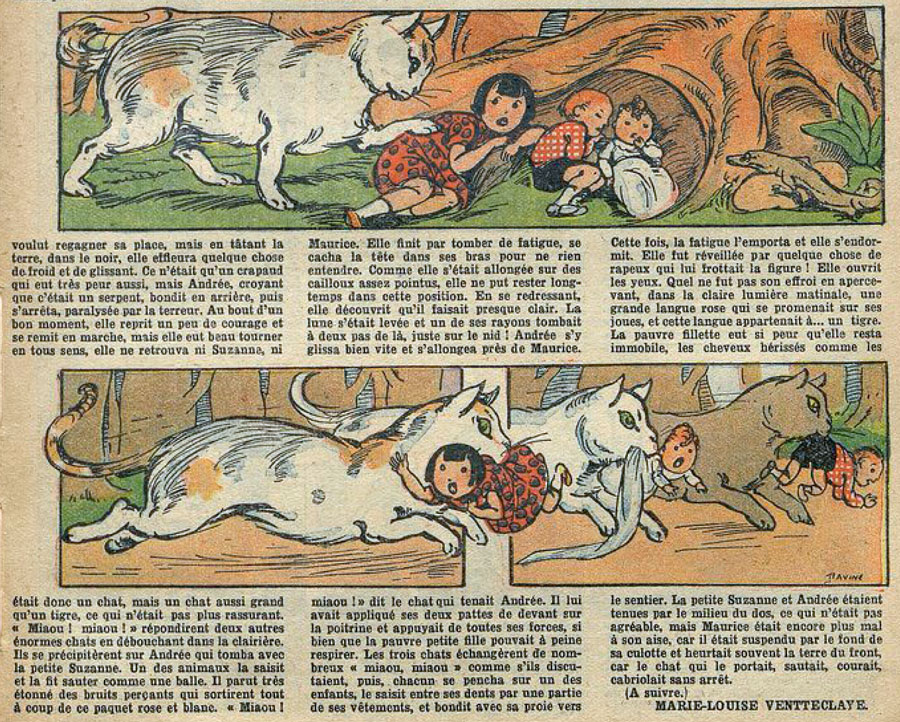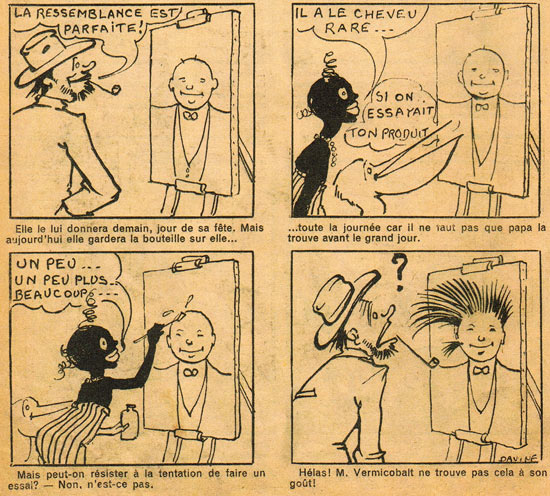'Bibor et Tribar', signed by both Rob-Vel and Luc Lafnet (26 May 1938).
Luc Lafnet was a Belgian painter, etcher and illustrator, and the regular assistant of Blanche Dumoulin and her French husband Robert Velter (Rob-Vel). During the 1930s, he worked with the pair on their comics 'Spirou', 'Bibor et Tribar' and 'Les Aventures de Zizette' for the Belgian weekly Spirou, but he made comics for French magazines as well. For his commercial work, Lafnet used several pseudonyms, including Davine. For a long time, this name was believed to be used only by Blanche Dumoulin, but it was later discovered that both Lafnet and Dumoulin have signed work with it. As Lafnet was a regular co-worker of the Velters, there is a possibility that Spirou's debut comic book page was in fact drawn by Lafnet and not Rob-Vel himself. A supposed self-portrait on the same page makes this assumption even more plausible. During his lifetime, Luc Lafnet was mostly known for his paintings of religious scenes, while on the side he illustrated erotic BDSM pulps under the name Jim Black.
Early life and career
Lucien Lafnet was born in 1899 in the industrial city of Liège, Belgium. He studied at the Academy of Fine Arts in his birth city, where the engravers Adrien De Witte and François Maréchal were among his teachers. With his bohemian appearance, Lafnet was a member of several Liège art groups, including Les Hiboux, Le Cénacle and La Caque, which he founded personally. He also became close friends with the novelist Georges Simenon (of 'Inspector Maigret' fame). In 1916, Lafnet had already been awarded the "Médaille du Gouvernement" for his work as a painter, and in the following year, he came in second in the "Prix de Rome". During this period, he also became friends with Blanche Dumoulin, a fellow Liège artist and future wife of the French comic artist Rob-Vel.
Erotic art for 'Dresseuse d'Hommes' by "Jim Black".
French career
From 1922 on, Lafnet was active as an etcher, painter and muralist in Paris, France, where he was later joined by Georges Simenon. He mainly painted and etched religious scenes, and also made murals for the monastery at Pont l'Abbé d'Arnoult and several churches in the Montmartre district of Paris. He was additionally active as an illustrator, for instance for an edition of Charles De Coster's 'Légendes Flamandes' (originally illustrated by Félicien Rops). Lafnet illustrated books by Georges Simenon, Charles Baudelaire, Marquis de Sade and Théophile Gautier, as well as advertisements and children's magazines.
Erotic art
Contrasting sharply with his religious work, Lafnet had a secret career on the side as an illustrator of erotic pulp stories. As "Jim Black", he illustrated a great many BDSM works, often with Amazonian women thrashing and humiliating men with whips and belts. Particularly his etchings for Florence Fulbert's 'Dresseuse d'Hommes' (1931) and Sophia Furrya's 'Les Geôles de Dentelles' (1933) stand out.
'Le Disque Enchanté', picture story in Fillette (20 May 1934).
The mysterious Davine
During his relatively short career, Luc Lafnet has used a variety of pseudonyms. He signed his advertising work with names like Lucan and Lafcat, his erotic illustrations with Grim, Jim Black, Lucas O, Rich, Pol or Viset, and his comics with Davine. The latter pen name was for many years solely attributed to Blanche Dumoulin for her illustration work in the magazines and books published by the Dupuis publishing house in Belgium (Bonnes Soirées, Le Moustique, Spirou). It wasn't until the Dupuis historians Christelle and Bertrand Pissavy-Yvernault researched the origins of the 'Spirou' comic for the 2013 books 'Spirou Par Rob-Vel: L'Intégrale 1938-1943' and 'La Véritable Histoire de Spirou: 1937-1946', that the origins of the Davine name became more public knowledge.
'Les Aventures de Zizette' (26 May 1938), mostly signed with Davine but this time with "Laf and Dav".
After spending five years working as a nanny in Sydney, Australia, Blanche Dumoulin returned to Europe in 1932, and joined her old friend Luc Lafnet in Paris two years later. Around 1934, the two began sharing the pen name of Davine for their work in children's and women's magazines. While it is possible that both Lafnet and Dumoulin used the Davine name for their individual illustration work, the two Dupuis historians have suggested that Dumoulin mostly acted as Lafnet's agent, while also helping him with writing his comic stories. Starting in 1934, the "Davine" name began appearing in children's magazines like Pierrot (the 1934 serial 'Paris-Saïgon'), Fillette (the 1934 serial 'Le Disque Enchanté'), Ric et Rac, Cadet Rousselle and Guignol. Between 1934 and 1937, Davine was present in Le Dimanche Illustré with 'Nestor', a cartoon feature about a mischievous child with a lot of imagination, who invents improbable ways to play sports in his apartment. In the mid-1930s, illustrations signed with Davine also appeared on the front page of Bonnes Soirées, a women's weekly published by Dupuis in Belgium. In 1936, Lafnet was illustrating crime novels in the Dupuis collection 'Police-Aventure', signed Davine.
In the second half of the 1930s, Davine created comics like 'Bizouk et Pélik' (1936-1938) for Le Journal de Bébé and 'Moustique Reporter' (1937) in Le Bon Point Amusant, both believed to be Luc Lafnet creations written by Blanche Dumoulin. The melodramatic Davine serial 'Les Aventures de Zizette' in the early 1938-1939 issues of Spirou magazine had the same art style as these previous comics, so Lafnet was most likely the artist and Dumoulin the writer. Some 1938 episodes of 'Zizette' were however signed by "Laf & Dav" ("Lafnet & Davine), leading to believe that Dumoulin eventually fully adopted the signature.

Was the painter from the very first Spirou page a self-portrait?
Assistance of Rob-Vel
In the period 1938-1939, Luc Lafnet also assisted Dumoulin's husband Robert Velter on his work for the new Belgian comic magazine Spirou. Commissioned by Dupuis in Belgium, Velter and his wife had developed a bellboy mascot called Spirou. Since Velter already had a steady workload for the French press - he was creating the newspaper strip 'M. Subito' and the title feature of Le Journal de Toto - it seems plausible that he outsourced a large part of this new Belgian assignment to his friend Luc Lafnet. In 2013, the two Dupuis historians Christelle and Bertrand Pissavy-Yvernault even mentioned the possibility that it was not Velter but Lafnet who drew Spirou's first appearance on the front page of the first issue on 21 April 1938. In his debut comic, Spirou is literally brought to life by a painter with his "eau de vie". The featured painter showed great similarities to Luc Lafnet's own appearance and might have been a self-portrait. On the other hand, it is also possible that Velter only drew the main Spirou character and Lafnet did the others, while another option is that Velter modeled the painter after Luc Lafnet as a tribute to his friend. Nonetheless, Lafnet's involvement in the artwork of the early 'Spirou' pages can be recognized through the artist's fond use of caricatural and grotesque side characters. Luc Lafnet is also most likely the ghost artist of Rob-Vel's other features in Spirou magazine, the gag strip 'Babouche' (1938) and the serial about the bumbling sailors 'Bibor et Tribar' (1938-1939).
Death
In March 1939, Luc Lafnet had to cancel his work for the Velters because of illness. Around that same period the signature of Davine disappeared from Le Journal de Spirou's illustrated text stories. Lafnet died from pancreatic cancer in September of that same year in the Parisian suburb Rueil-Malmaison. His pen name Davine lived on for a short while in the work of Blanche Dumoulin, who continued to draw the 'Spirou' comic with the help of J. Van Straelen and other anonymous assistants while her husband was mobilized in 1940. In October of that year, she was forced to pass the pencil to the Belgian artist Jijé because of wartime postal problems. The signature Davine was not seen again.
While the true story nature Luc Lafnet's role in the creation of one of Europe's most iconic comic characters shall perhaps always remain uncertain, it can safely be stated that Robert Velter has to share his credit as creator of Spirou with both Luc Lafnet and Blanche Dumoulin, the authors behind the pen name Davine.
'Bizouk et Pélik', signed Davine (10 March 1938).








